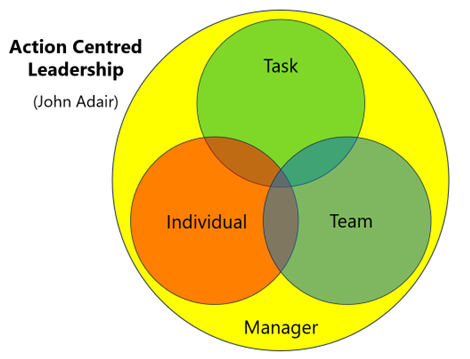Welcome back to our series on Action Centred Leadership, where we explore the principles and practices of effective leadership. In this blog we delve into the “Task” element of the Action Centred Leadership model.
If we refer to the ‘Action Centred Leadership’ diagram above, where should a manager spend most of their time?
Certainly, pre-Covid, the majority of managers might have said (in order) ‘task, team, individual’, meaning that they focused on the tasks and objectives, rather than the individual.
This is also because the focus from upper management is often on KPI’s and targets as that is what they are measured against, and these normally align with any tasks.
The Task Element breakdown
Parts of this element include;
-
- Why are we doing this (is this the best way, does it align with organisational goals?)
- Planning and plan B creation (what alternatives do we need, and when will we need them? e.g. if resources are not available)
- Controls and safeguards – what risks and challenges are we likely to face and how can we manage those. Recognising that we should not expect things to always go to plan.
- Monitoring progress against the plan, and understanding why there are deviations (what Lessons have we Learnt?)
What’s Changing?
Post-Covid, however, and with the rise in hybrid working, organisations are much more aware of employees’ needs and, indeed, employee expectations are for a much more personal approach. This may vary e.g. in manufacturing and production industries.
The advantage is that by balancing with time spent on the individual, the individual will be motivated to get the task done to a better quality, than if the focus is purely on getting the task done. Employees may rush through, just to tick a task off.
Where possible, it is also important to identify the right person(s) for the task i.e. does the task fit with their development needs, and is it seen of as ‘of value’ to the employee. Again, this ensures ownership and a better buy in from the individual.
Are there opportunities for teamwork or co-working (or buddying)? This is especially good for larger tasks that can be broken down.
SMART Goals (Doran, Miller & Cunningham)
These are useful in communicating and aligning the individual and team needs to the tasks. They should be used as a discussion framework to define the responsibilities and accountabilities of a task, set expectations, agree standards (such as ‘success criteria’) and ensure buy in from others, and gain a clear understanding of the importance of the task and its challenges (in which case, suitable support can then be agreed).
Often forgotten are the expected benefits of any successful completion. This is related to the ‘why’ question earlier, but can be analysed after the event to see if the projected benefits (or additional ones) were attained – or not ! (in which case, what are the impacts?)
Other business models, such as Stephen Covey’s ‘Time Management Matrix’ can be linked to help prioritise tasks.
While not expressly identified, links and interactions with other departments (incl. upper management) and key personnel (external SME’s?) need to be identified as they may play a part in any reviews or reporting.
Keep an eye out for part 3 coming soon – we will be having a look at the “Team Element.” – this will explain the components of it, as well as challenges managers face in their working day!





